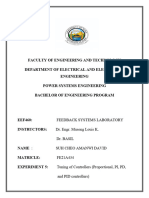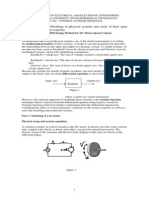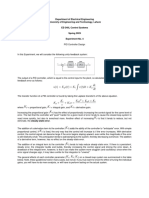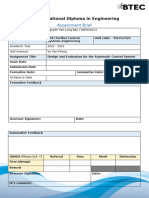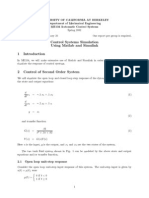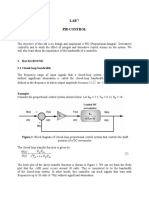Lab 3
Uploaded by
bassmalabaraaLab 3
Uploaded by
bassmalabaraaContinuous control System 3 rd year Electrotechnics EEA Department
Lab 03 (Closed-loop performances)
Starting ideas:
I
n this Lab, we will try to cover the principal aspects on closed-loop performances, as we have
seen in the course, the performances of a close-loop system are divided into transient and
steady-state stage. In the first one, we are interesting to satisfy some specifications in time
domain like Rise time, Settling time, Peak time, Response time and percentage of overshoot. In the
other side, the steady-state specification is covering by the error between the desired input and the
system’s response, in unit step case, the error is called position (labeled by 𝐾𝑝 ) and when the input
is a ramp signal, the error is called velocity (labeled by 𝐾𝑣 ), and in case of a parabolic input, the
error is called acceleration (labeled by 𝐾𝑎 ).
Three parts will be addressed in this Lab:
• Position, velocity and acceleration error.
• Stability and Transient response performances.
• PID tuning
Materials: Computer included a MATLAB software with Word editor to prepare the final report.
Time-duration : 1H30min
Documents allowed: Course (chapter-3)
DR. Abdelhamid Bounemeur
Continuous control System 3 rd year Electrotechnics EEA Department
Part A: (steady-state study):
MATLAB commands needed: (see the code below)
clear all
clc
gf=tf([4],[1 2,10]); % the open-loop transfer function (feedforward)
gc=feedback(gf,1);% the closed-loop transfer function for a unity feedback
t=0:0.01:20; % simulation time
%%%%%% If the input is a unit step you can use step(gc) or you can use the
following commands)
u=ones(size(t));% the input is a unit step
lsim(gc,u,t);% plot the unit step response of the closed-loop system
%%%% If the input is ramp%%%%%%
u=t;
lsim(gc,u,t);
%%%% If the input is a parabolic%%%%
u=t.^2;
lsim(gc,u,t);
1. Determine graphically the steady-state error for a unit step input, unit ramp input and unit
parabolic input for the control system described by the following transfer function :
2. For the following control system determine graphically the steady-state error for the inputs: 5𝑢(𝑡),
5𝑡𝑢(𝑡), and 5𝑡2 𝑢(𝑡)
DR. Abdelhamid Bounemeur
Continuous control System 3 rd year Electrotechnics EEA Department
3. For the control system described by the following feed forward transfer function determine the
steady-state error for the input 15𝑡2 𝑢(𝑡)
4. Design the following control system by selecting a value of 𝐾 graphically such that there is a
10% steady state error for a unit ramp input. Use the Routh-Hurwitz criterion to confirm that the
system is stable at the value of 𝐾 selected.
Part B: (Stability and Transient response performances):
1. Find the values of 𝐾 that make the system instable based on a simple MATLAB code of the
following system (this first simulation is just for smart students).
Hint: you must construct a vector that contains many values (for example K=[1:1500]) and replace
it in the characteristic equation and check the stability. You can use Routh array to find the stability
range.
2. Consider the closed-loop system defined by
DR. Abdelhamid Bounemeur
Continuous control System 3 rd year Electrotechnics EEA Department
Using a “for loop,” write a MATLAB program to obtain unit-step response of this system for
the following four cases:
First case: 𝜔𝑛 = 1; 𝜁 = 0.3
Second case: 𝜔𝑛 = 2; 𝜁 = 0.5
Third case: 𝜔𝑛 = 4; 𝜁 = 0.7
Fourth case: 𝜔𝑛 = 6; 𝜁 = 0.8
3. For the following block diagram:
• Find the closed-loop transfer function.
• Tune the pole P and the gain k to meet the following specifications (use stepinfo(g) to
confirm your choice):
-Percentage overshoot ≤ 5%
-settling time 𝑇𝑠 ≤ 4𝑠
Part C: (PID controller applied on a DC Motor): The open-loop transfer function of the DC Motor
is given as follows (see the chapter-1 in case of torque constant is equal to the back EMF constant).
The structure of the control system has the form shown in the figure below.
DR. Abdelhamid Bounemeur
Continuous control System 3 rd year Electrotechnics EEA Department
For a 1-radian step reference r(t), the design criteria are the following.
▪ Settling time less than 0.040 seconds
▪ Overshoot less than 16%
▪ No steady-state error
The motor parameters are listed below:
J = 3.2284E-6;
b = 3.5077E-6;
K = 0.0274;
R = 4;
L = 2.75E-6;
Recall that the transfer function for a PID controller has the following form.
Proportional controller only P: (𝒅 = 𝟎)
DR. Abdelhamid Bounemeur
Continuous control System 3 rd year Electrotechnics EEA Department
• In the first tuning, use only the proportional controller and sketch the step response for
different values of 𝐾𝑝 = 1, 11, 21.write the transient response performances for the
considered three case (use the command stepinfo(closed-loop).
• Give your remarks on how the 𝐾𝑝 value can affect the steady-state error and the transient
response
Proportional and integral controller PI: (𝒅 = 𝟎)
• Try to set the value of 𝐾𝑝 = 21 and 𝐾𝑖 = 100, 300, 500.
• Plot the step response with PI controller for the three given values of 𝐾𝑖.
• Give your remarks on how the value of 𝐾𝑖 can affect the steady-state error and the transient
response
• Put the Disturbance 𝑑 = 1 and plot the step response in this case.
Proportional, integral, and derivative controller PID: (𝒅 = 𝟎)
• Adding a derivative term to the controller means that we now have all three terms of the PID
controller. We will investigate derivative gains 𝐾𝑑 ranging from 0.05 to 0.25 along with the
same gains as in PI controller (𝐾𝑝 = 21 and 𝐾𝑖 = 500).
• Plot the step response with PID controller.
• Give your remarks on how the value of 𝐾𝑑 can affect the steady-state error and the transient
response
• Put the Disturbance 𝑑 = 1 and plot the step response in this case.
DR. Abdelhamid Bounemeur
You might also like
- 28 Fresh ESL Vocabulary Words For SpringNo ratings yet28 Fresh ESL Vocabulary Words For Spring4 pages
- Lab 2 - Analyze The Performance of Control SystemNo ratings yetLab 2 - Analyze The Performance of Control System11 pages
- 2.004 Dynamics and Control Ii: Mit Opencourseware100% (1)2.004 Dynamics and Control Ii: Mit Opencourseware7 pages
- Experiment No. 02 Name of The Experiment: Modeling of Physical Systems and Study of Their Closed Loop Response ObjectiveNo ratings yetExperiment No. 02 Name of The Experiment: Modeling of Physical Systems and Study of Their Closed Loop Response Objective6 pages
- Name: Zulfiqar Ali.: Department of Electronic Engineering University of Engineering and Technology Abbottabad CampusNo ratings yetName: Zulfiqar Ali.: Department of Electronic Engineering University of Engineering and Technology Abbottabad Campus15 pages
- Motor Modeling and Position Control Lab Week 3: Closed Loop ControlNo ratings yetMotor Modeling and Position Control Lab Week 3: Closed Loop Control14 pages
- Lab 12: Maglev Control 12/8/2010 Frank Laritz II Maxim Markov Alex ProgNo ratings yetLab 12: Maglev Control 12/8/2010 Frank Laritz II Maxim Markov Alex Prog14 pages
- Control Systems PID Controller Solved ManualNo ratings yetControl Systems PID Controller Solved Manual17 pages
- EE131 Comprehensive Exam 2nd Sem 2019-2020No ratings yetEE131 Comprehensive Exam 2nd Sem 2019-202010 pages
- Course Code and Title:: EEE 402: Control SystemsNo ratings yetCourse Code and Title:: EEE 402: Control Systems8 pages
- CHAPTER 1: Plant Process Characterization and PID: TheoryNo ratings yetCHAPTER 1: Plant Process Characterization and PID: Theory10 pages
- Higher National Diploma in Engineering: Assessment BriefNo ratings yetHigher National Diploma in Engineering: Assessment Brief22 pages
- Automatic Control System - Final ProjectNo ratings yetAutomatic Control System - Final Project45 pages
- Matlab, Simulink - Control Systems Simulation Using Matlab and SimulinkNo ratings yetMatlab, Simulink - Control Systems Simulation Using Matlab and Simulink10 pages
- Department of Engineering Technology GET 431/EET 441 Controls Lab Spring, 2018No ratings yetDepartment of Engineering Technology GET 431/EET 441 Controls Lab Spring, 20185 pages
- Assignment 2 Stability, Steady State Error, PIDNo ratings yetAssignment 2 Stability, Steady State Error, PID9 pages
- CHAPTER 1: Plant Process Characterization and PID: TheoryNo ratings yetCHAPTER 1: Plant Process Characterization and PID: Theory9 pages
- Emt30105-Lab 3-Close Loop System With Pid Controller - Hafiz Zikri Bin Norizan-191492857-Ry88No ratings yetEmt30105-Lab 3-Close Loop System With Pid Controller - Hafiz Zikri Bin Norizan-191492857-Ry8811 pages
- Controller Tuning: CHME 624 Advance Process Dynamic Modelling & ControlNo ratings yetController Tuning: CHME 624 Advance Process Dynamic Modelling & Control15 pages
- LAB#0 Planning Lab For Control Engineering ObjectiveNo ratings yetLAB#0 Planning Lab For Control Engineering Objective3 pages
- Control of DC Motor Using Different Control StrategiesFrom EverandControl of DC Motor Using Different Control StrategiesNo ratings yet
- Simulation of Some Power System, Control System and Power Electronics Case Studies Using Matlab and PowerWorld SimulatorFrom EverandSimulation of Some Power System, Control System and Power Electronics Case Studies Using Matlab and PowerWorld SimulatorNo ratings yet
- Nonlinear Control Feedback Linearization Sliding Mode ControlFrom EverandNonlinear Control Feedback Linearization Sliding Mode ControlNo ratings yet
- Investigation of the Usefulness of the PowerWorld Simulator Program: Developed by "Glover, Overbye & Sarma" in the Solution of Power System ProblemsFrom EverandInvestigation of the Usefulness of the PowerWorld Simulator Program: Developed by "Glover, Overbye & Sarma" in the Solution of Power System ProblemsNo ratings yet
- Different Kinds of Drugs and Its EffectsNo ratings yetDifferent Kinds of Drugs and Its Effects13 pages
- Blockchain: Research and Applications: Lodovica Marchesi, Michele Marchesi, Roberto Tonelli, Maria Ilaria LunesuNo ratings yetBlockchain: Research and Applications: Lodovica Marchesi, Michele Marchesi, Roberto Tonelli, Maria Ilaria Lunesu13 pages
- Cryptographic Algorithm Validation ProgramNo ratings yetCryptographic Algorithm Validation Program21 pages
- Sample Social Media Policy For EmployersNo ratings yetSample Social Media Policy For Employers3 pages
- Ear Lobe Patterns Comparison Among Males and Females of Madhya PradeshNo ratings yetEar Lobe Patterns Comparison Among Males and Females of Madhya Pradesh6 pages
- Specialist Gynaecologist Hamilton Waikato NZ 3204No ratings yetSpecialist Gynaecologist Hamilton Waikato NZ 32043 pages
- English Sheet Test 3, 5 & 9 10.04.25 Home WorkNo ratings yetEnglish Sheet Test 3, 5 & 9 10.04.25 Home Work5 pages
- Experiment No. 02 Name of The Experiment: Modeling of Physical Systems and Study of Their Closed Loop Response ObjectiveExperiment No. 02 Name of The Experiment: Modeling of Physical Systems and Study of Their Closed Loop Response Objective
- Name: Zulfiqar Ali.: Department of Electronic Engineering University of Engineering and Technology Abbottabad CampusName: Zulfiqar Ali.: Department of Electronic Engineering University of Engineering and Technology Abbottabad Campus
- Motor Modeling and Position Control Lab Week 3: Closed Loop ControlMotor Modeling and Position Control Lab Week 3: Closed Loop Control
- Lab 12: Maglev Control 12/8/2010 Frank Laritz II Maxim Markov Alex ProgLab 12: Maglev Control 12/8/2010 Frank Laritz II Maxim Markov Alex Prog
- CHAPTER 1: Plant Process Characterization and PID: TheoryCHAPTER 1: Plant Process Characterization and PID: Theory
- Higher National Diploma in Engineering: Assessment BriefHigher National Diploma in Engineering: Assessment Brief
- Matlab, Simulink - Control Systems Simulation Using Matlab and SimulinkMatlab, Simulink - Control Systems Simulation Using Matlab and Simulink
- Department of Engineering Technology GET 431/EET 441 Controls Lab Spring, 2018Department of Engineering Technology GET 431/EET 441 Controls Lab Spring, 2018
- CHAPTER 1: Plant Process Characterization and PID: TheoryCHAPTER 1: Plant Process Characterization and PID: Theory
- Emt30105-Lab 3-Close Loop System With Pid Controller - Hafiz Zikri Bin Norizan-191492857-Ry88Emt30105-Lab 3-Close Loop System With Pid Controller - Hafiz Zikri Bin Norizan-191492857-Ry88
- Controller Tuning: CHME 624 Advance Process Dynamic Modelling & ControlController Tuning: CHME 624 Advance Process Dynamic Modelling & Control
- LAB#0 Planning Lab For Control Engineering ObjectiveLAB#0 Planning Lab For Control Engineering Objective
- Control of DC Motor Using Different Control StrategiesFrom EverandControl of DC Motor Using Different Control Strategies
- Simulation of Some Power System, Control System and Power Electronics Case Studies Using Matlab and PowerWorld SimulatorFrom EverandSimulation of Some Power System, Control System and Power Electronics Case Studies Using Matlab and PowerWorld Simulator
- Nonlinear Control Feedback Linearization Sliding Mode ControlFrom EverandNonlinear Control Feedback Linearization Sliding Mode Control
- Investigation of the Usefulness of the PowerWorld Simulator Program: Developed by "Glover, Overbye & Sarma" in the Solution of Power System ProblemsFrom EverandInvestigation of the Usefulness of the PowerWorld Simulator Program: Developed by "Glover, Overbye & Sarma" in the Solution of Power System Problems
- Blockchain: Research and Applications: Lodovica Marchesi, Michele Marchesi, Roberto Tonelli, Maria Ilaria LunesuBlockchain: Research and Applications: Lodovica Marchesi, Michele Marchesi, Roberto Tonelli, Maria Ilaria Lunesu
- Ear Lobe Patterns Comparison Among Males and Females of Madhya PradeshEar Lobe Patterns Comparison Among Males and Females of Madhya Pradesh










